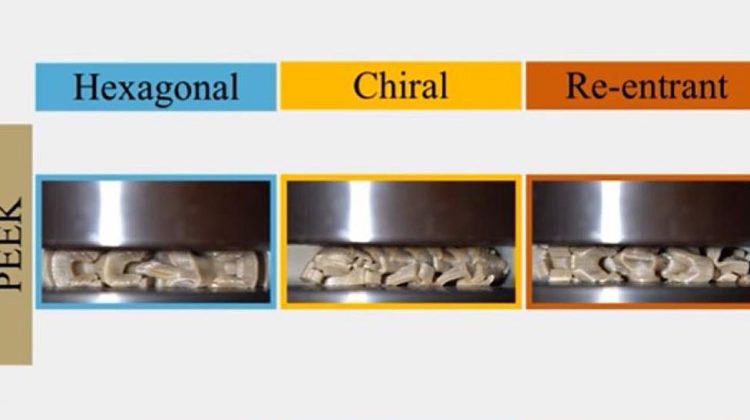
Prosthetic devices and medical implants that can sense when they’ve been damaged may become a possibility thanks to the development of a new form of lightweight, impact-resistant plastic-based ‘honeycomb’ structures by a research team led by engineers at the University of Glasgow.
The team used 3D printing techniques to add new properties to a plastic known as polyether ether ketone, or PEEK, a non-conductive material whose mechanical properties and resistance to high temperatures and chemicals have made it useful for a wide range of applications in the aerospace, automotive and oil and gas industries. By adding micro-scale carbon fibres to their cellular PEEK structures, they gave the material the ability to carry an electric charge throughout its structure. This gave rise to the possibility that damaging the electro-conductive cellular PEEK composite would affect its electrical resistance, thus giving the new material the ability to ‘self-sense’. A hip implant that incorporated the material could potentially report when its conductivity had changed, indicating that it had worn down and needed to be replaced.
The team used both the carbon-fibre PEEK material and conventional PEEK to create three different honeycomb configurations – a hexagonal structure, a cross-shaped chiral structure and a six-sided re-entrant design – using 3D printing. They then to subjected them to crush and impact tests to compare the abilities of the different materials to absorb energy.
In the crush tests, in which consistent pressure is applied until the structure collapsed, the conventional PEEK outperformed the carbon-fibre PEEK, withstanding higher pressures. However, in impact tests, in which a weight is dropped from height onto the structures, all three carbon-fibre PEEK structures exhibited greater resistance to damage, with the hexagonal honeycomb configuration withstanding the greatest impacts.
In the crush tests, the researchers also measured the carbon-fibre PEEK’s resistance to an electric charge as the three different structures were strained – a phenomenon known as piezoresistive sensitivity that is exploited in commercial pressure sensors. They found that the change in electrical resistance in response to the applied strain decreased as the compressive strain increased, leading to a near complete loss of electrical resistance when the structures were completely crushed, suggestingthat the carbon-fibre PEEK’s piezoresistivity could make it suitable for a new generation of ‘smart’ devices.
‘The unique properties of PEEK have made it invaluable to many industrial sectors and we hope that the carbon-fibre engineered PEEK cellular structures that we’ve been able to build via 3D printing will open up further possibilities,’ said Shanmugam Kumar of the University of Glasgow’s James Watt School of Engineering, who worked on the project.
‘3D printing gives us a remarkable amount of control over the design and density of the cellular structure,’ he continued. ‘That could allow us to build materials that more closely resemble the physiology of the native bone than the solid metal alloys traditionally used in medical implants such as hip or knee replacements, potentially making them more comfortable and effective. We hope that these cellular forms of micro-engineered, lightweight, self-sensing PEEK we’ve developed will find new applications in a wide range of fields, not just in prosthetics and other medical devices but also in automobile design, aerospace engineering and the oil and gas sector.’
The research is described in a paper recently published in the journal Materials & Design.



